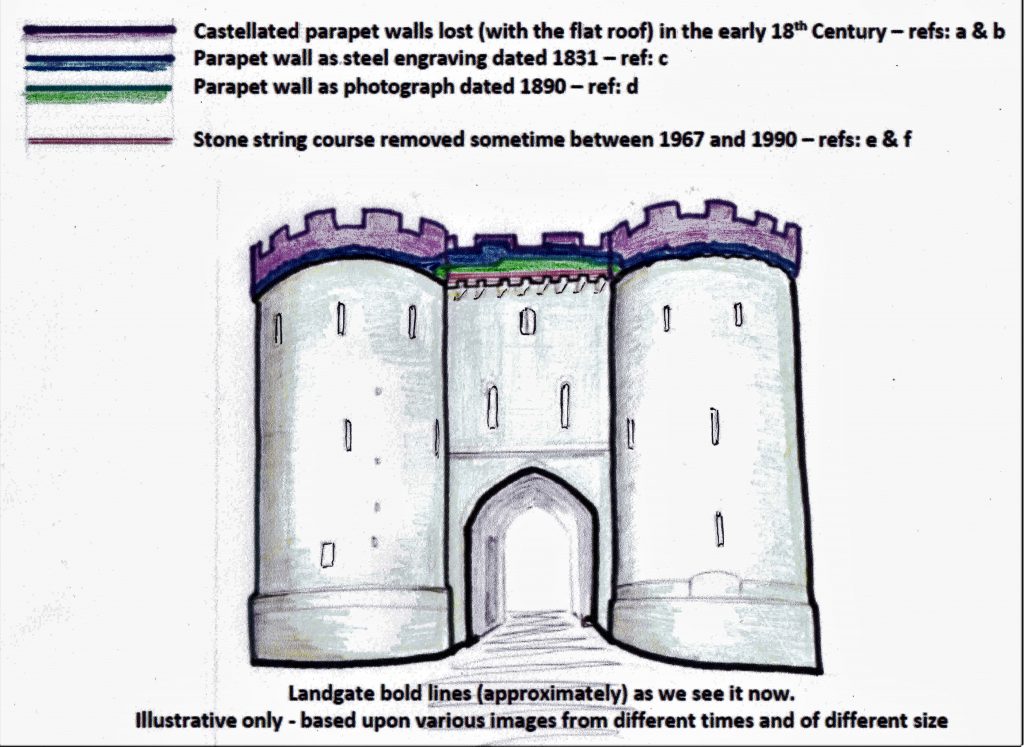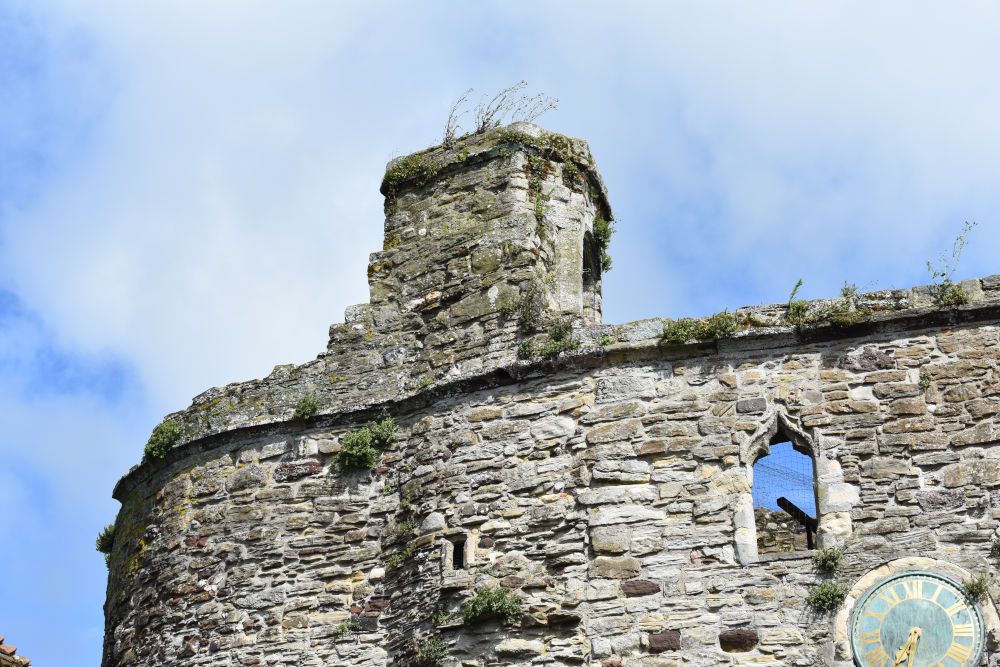Thanks to those who provided further information following my article in Rye News on 22 April 2021.
I am now reasonably confident about the history and the condition of Landgate through time. As stated in the first article “It is helpful to look back and get a measure of how the structure has performed in the past, before looking forwards, to plan how to conserve the structure in the future.”
Roof and Parapet Walls
Drawings/sketches a & b from the mid-17th century (1633 and 1659) show the Landgate with castellated parapet walls at the top. The flat roof/deck behind the parapet walls provided a place from which stones and hot liquids could be dropped onto attackers outside the entrance.
Reports indicate that the roof and parapet walls were removed early in the 18th century, although one report is as late as 1753 i.e. maybe 100 years after the drawings/sketches referred to above. Clearly, it was only the parapet walls around the drum towers that were removed, as an engraving and photographs show the parapet wall above the entrance remaining until at least 1890. My previous article in Rye News described the condition of the structure in 1890 and that significant masonry repairs were carried out soon after. It is likely that the remaining parapet wall was taken down at the same time as the repairs to the main walls. The stone string course that supported the parapet wall above the entrance remained until at least 1967.

Lost from the top down
The reality is that the Landgate is gradually being lost from the top down. This is not a recent phenomenon. It started soon after the Landgate was built in the 14th century. The parapet walls above a flat roof/top deck, were exposed on both sides, to wind, rain and frost. These would have deteriorated first. The structure did well to last nearly 400 years in its original form. It is likely that the structure was in very poor condition by the early 18th century. By that time, the Landgate had little purpose or use. The parapet walls might have fallen (in part) or been taken down. In the process the flat roof might have come down or been removed. My guess is that the “local authority” at that time, did not have enough money to preserve or replace parts of the structure. It is likely that the masonry and any larger timbers would have been re-used (it was not a throw-away society).
Removal of the roof opened-up the structure to the weather, wind, rain and frost, thus causing the masonry walls to deteriorate at a faster rate. It is the removal of the roof that has resulted in accelerated loss of the Landgate from the top-down.
Structure in 1890
By 1890 the structure was in poor condition. The 1890 photograph shows that the stonework facing on the north side was being lost. The “local authority” at that time found funds for fairly major repairs. However, the structure had no purpose or use, at that time. The investment was much needed but did not stretch to replacing the roof. The remaining parapet wall was removed. The structure remained open to the elements. Wind, rain and frost continued to cause damage. The structure was now about 550 years old.
Further repairs
As reported previously, further repairs were carried out between the mid 1950s and 1960s and again in about 1990. At about 1990 the stone string course, which supported the parapet wall above the entrance, was lost. Although a relatively small loss, the string course was a big loss in terms of understanding how the entrance was defended. The machicolations (openings between the supporting corbels of a projecting parapet) were lost by removal of the string course. It is now more difficult to explain to small boys and girls, that rocks, burning objects and hot liquids could be dropped through the holes onto attackers below. In my opinion that is a real shame, an important loss.
A future for the Landgate
This review reveals that the need for repair has become more regular over the life of the Landgate, We can speculate that major works were needed after approximately 400 years, then after another 150 years, then after another 50 years and then 40 years later. 2021 is about 30 years on from the last significant repairs. The interval is shortening; some would say exponentially! Surely, the time is right to plan a longer-term strategy in order to prolong the life of the Landgate?
So, contrary to recent (and repeated) suggestions that the demise of the Landgate is through a lack of action by Rye, Rother, East Sussex or others, I can confirm that the demise of the Landgate started years ago. The structure is now approaching 700 years old. Lack of maintenance, repair or replacement more than 300 years ago, resulting in removal of the parapet walls and roof nearly 300 years ago, is the biggest failure. Can you blame our predecessors from that time? The structure had lost its purpose and had no use. They had no money!
Maintenance has been carried out in the last 130 years, thanks to local authorities, Rye Town Council and Rother District Council. Both councils, together with Rye Conservation Society and English Heritage, are now collaborating to find the most sensible way of preserving the Landgate. It does now have a purpose, as it attracts tourists and that helps the local economy. Also, people generally have a much better appreciation of history and the character of their local built environment. That means we should be optimistic about the future of the Landgate. Watch this space!
On the subject of the current maintenance, Helena Kojevnikov comments “On 1 July, I passed a group of tourists on the corner of Cinque Ports Street and the Landgate. They were expressing surprise about the tree growing (yet again!) from the top of the construction and saying that obviously, the locals don’t care, or they would have it removed. I would donate toward the cost of having that pestilential buddleia (?) destroyed once and for all. Does anyone else care?”
References
a 1633 Sketch by Anthony Van Dyck Anthony van Dyck | View of Rye from the Northeast | Drawings Online | The Morgan Library & Museum
b 1659 print; map | British Museum
c 1831 http://www.bl.uk/onlinegallery/onlineex/topdrawings/l/005add000005670u00029000.html
d 1890 https://images.app.goo.gl/qRVBHuwEeuLmUqy26
e 1967 https://ryesown.co.uk/bus-operators-of-rye-district/
f 1990 https://www.fncisfrith.com/rye/rye-the-landgate-c1990_r77709k
Image Credits: Rye News library , Geoffrey Austen .




I would like to think lots of people care. And perhaps most of all, all businesses around The Landgate and along the high street should very much care. At the very least, couldn’t all business place a collection box for The Landgate, or add 50p or £1 to bills ? Couldn’t B&B and hotels add £1 per person a night to bills ? After all, when tourists go to American states such as Las Vegas a charge is added to bills for electricity consumption tax. If you want to show people care, let’s see some unity and get something done. And what’s so hard about getting someone with a saw to cut down the tree or is it a namby-pamby Healthy & Safety issue ?
Andrew, the final paragraph was not mine but I can understand the frustration. I am certain that lots of people care.
Rye councillors and others, with Rother are in the process of establishing a longer-term approach. Sorry if this takes time but that’s how things are. Councils have to face lots different challenges and they are accountable, so things have to be demonstrably justifiable. Also, yes, health and safety are very important and currently access to the top of Landgate is difficult.
A small (manageable) group is putting together justification for managing Landgate better. The aim is to prolong its life and facilitate easier maintenance. We want tourists to know that we care.
One of my recent experiences was turning from Landgate into Tower Street to hear an excited young boy, bouncing along and exclaiming loudly “Look mummy, it’s a castle”. Magic! It took me back 60 years. Let’s keep it that way for future generations and perhaps provide educational information, so that young visitors grow to understand that it was a gateway into Rye and that there is lots of other fantastic history to explore in Rye.